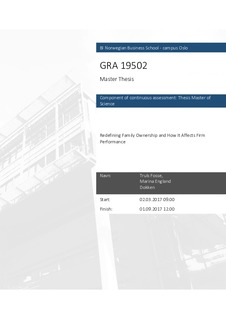Redefining family ownership and how it affects firm performance
Master thesis
Permanent lenke
http://hdl.handle.net/11250/2484400Utgivelsesdato
2017Metadata
Vis full innførselSamlinger
- Master of Science [1621]
Sammendrag
Through this thesis, we want to challenge the established family firm definition of
50% family ownership. We do this by incorporating additional criteria such as
active management from the controlling family and a requirement that the
company has two or more owners from the same family. By implementing these
criteria, we aim to capture more of the features one expect to see when a company
is family owned. We will measure the effects by looking at firm performance and
compare the results from our new definition with the established definition.
This thesis uses panel data of Norwegian public and private companies over the
years 2000-2015 gathered from The Center for Corporate Governance Research.
Our sample consists of approximately 175.000 Norwegian companies.
The models used in this paper will always consist of one base case where family
ownership is measured by the variable “family ultimate ownership”, which
indicates percentage ownership of the controlling family. The base case is
compared against two different models where the first model uses the established
50% definition as a dummy variable and the second model uses our new
definition of family ownership. All these three cases include control variables for
firm age, firm size, leverage and industry risk. The dependent variables are return
on assets (ROA), return on equity (ROE), growth in assets and growth in
revenues.
The results from our analysis indicates that even though we use our new, stricter
definition of family ownership, family firms still outperform non-family firms
with reference to ROA and ROE. However, we see a negative impact on both
growth measures, which could be explained by higher risk aversion and long-term
thinking in family firms. Our findings, regarding the control variables for the new
family definition, also capture the effects and key features one would expect from
a family owned company.
Beskrivelse
Masteroppgave(MSc) in Master of Science in Business, Finance - Handelshøyskolen BI, 2017
